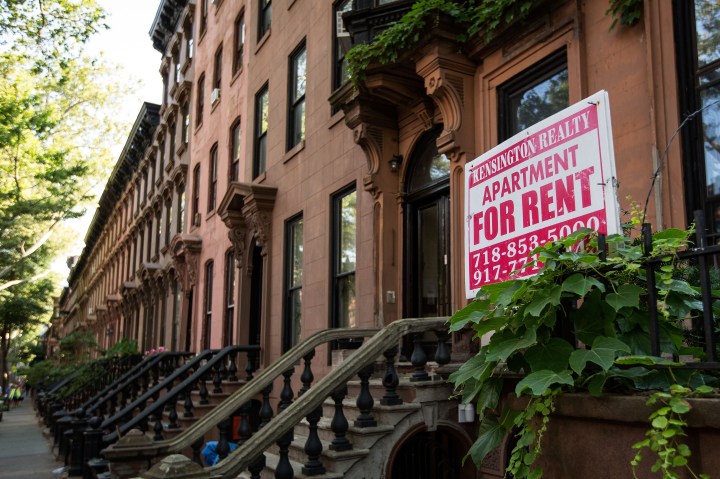
New index gets a “more real-time view” of rent inflation

For the most part, when the Federal Reserve examines rent prices in its inflation calculations, the age of a lease doesn’t matter. Whether it’s new or one that has been renewed annually for 10 years, they’re treated the same in the consumer price index. Measuring it this way is useful for finding the average amount of rent paid in a city, but less useful for figuring out something like how much more or less landlords are charging new occupants right now.
Late last year, the Bureau of Labor Statistics and the Federal Reserve Bank of Cleveland decided to try something new. They created the new tenant repeat rent index to track the change in rent among homes with new leases.
Joey Politano, an independent economics writer, joined “Marketplace’s” Kai Ryssdal to talk about the impact this new data could have. A transcript of their conversation is below.
Kai Ryssdal: I guess, first of all, we need to establish a little ground truth here, and I need you to explain for me how the government typically tracks rent inflation with a consumer price index, which is what most people are familiar with.
Joey Politano: Right, so housing is a really big deal in the consumer price index. It’s about a third of the total basket, and it’s the biggest single item. And so the government has to be really careful about how they’re measuring it. They want to get it precisely right. And so what they do essentially is come up with a big sample of housing units. Every six months, they go and visit those housing units and record what the price is, or if there was any change in the amenities, or if the unit was renovated, and so on. And they use that to back out an estimate for rent prices in the United States and also in your local city area. And they extrapolate that rent estimate for homeowners too.
Ryssdal: Right, and that’s that thing that we’ve talked about on the program called “owner’s equivalent rent.” But let me ask you this: Whatever the sample that the BLS uses, it’s not like people are signing new rental agreements every month, right? So that number gets stale.
Politano: Precisely, it lags by about a year. So you can imagine at the start of the pandemic that somebody records the price of an apartment in New York in January 2020. Then they don’t come back and visit that apartment until June of 2020, but that apartment might not sign a new lease until January of 2021. So you have this earth-shattering change in the housing market that happens at the start of the pandemic, and it really doesn’t fully show up [in the data] until a full year later.
Ryssdal: And now, as we’re worried about inflation — and by we, I mean specifically the Federal Reserve — them having year-old data is kind of a challenge.
Politano: Yeah, it’s a really big challenge. Housing is one of the biggest parts of inflation, and it’s one of the parts that the Federal Reserve’s monetary policy most heavily influences.
Ryssdal: Right. And we see that in mortgage rates and all the rest of it that we’ve talked about. So, to the point of this conversation and the reason we got you on the phone, this thing called the new tenant repeat rent index. First of all, in layman’s terms, please, what does that mean?
Politano: So what that means, essentially, is you take the official data that looks at all housing, and you want to throw out everything where there hasn’t been a new person moving in. So you have this subset of units where someone moves in, replaces the previous tenant, signs a new lease, and you’re going back and comparing and saying, “OK, we looked at this price when Person A signed a lease, now the Person B is signing a lease. What’s the price change?” And because you’re only looking at the subset, you get a much more real-time view of what the housing market looks like and what housing inflation is going to look like.
Ryssdal: So if you can get Jay Powell on the phone — which, you know, maybe you could, I don’t know — what would you tell him about how the Fed thinks about housing, specifically as it relates to inflation? Are they behind the curve, as it were?
Politano: I think the Fed understands this dynamic much more than people tend to give them credit for. What I would say if you’re talking to Jerome Powell right now is the core driver of inflation is, to some extent, nominal income growth. Like, what’s the growth in people’s ability to spend? And that translates really strongly to growth in housing prices and growth in rents. We’ve seen a pretty substantial deceleration in the growth in nominal income. And I’m confident that if that gets back down to a normal level, the core of housing inflation will follow. And so while this index is really useful, especially because things like household formation — so people deciding whether or not they want to move in together, live separately or stay with their parents or whatnot — can influence housing prices beyond just incomes, I think the core thing you have to look at is still income growth.
There’s a lot happening in the world. Through it all, Marketplace is here for you.
You rely on Marketplace to break down the world’s events and tell you how it affects you in a fact-based, approachable way. We rely on your financial support to keep making that possible.
Your donation today powers the independent journalism that you rely on. For just $5/month, you can help sustain Marketplace so we can keep reporting on the things that matter to you.

















